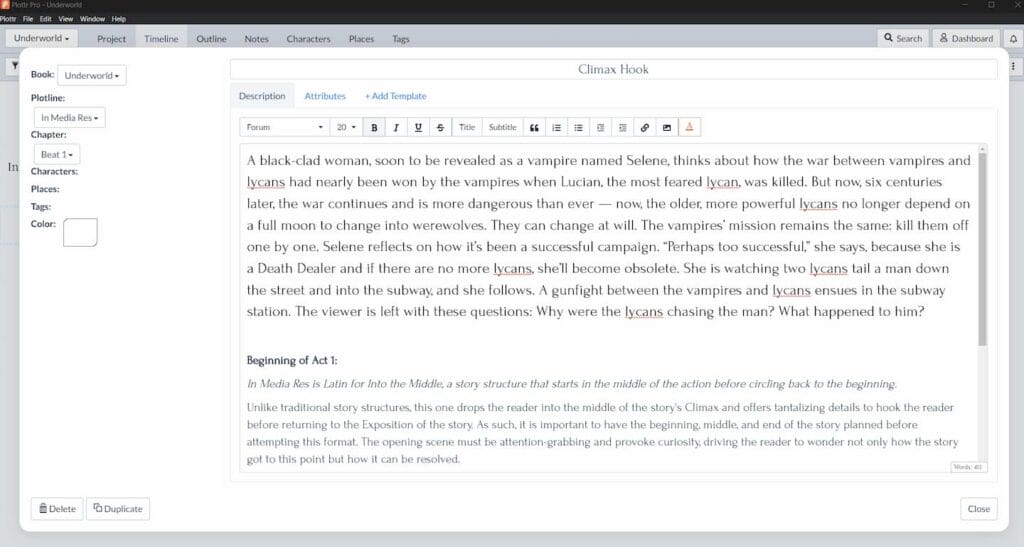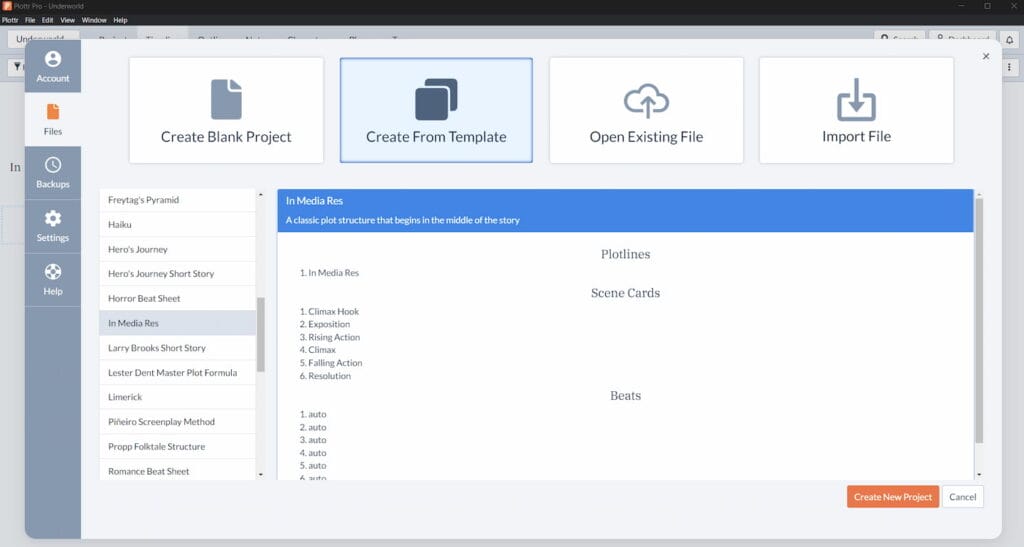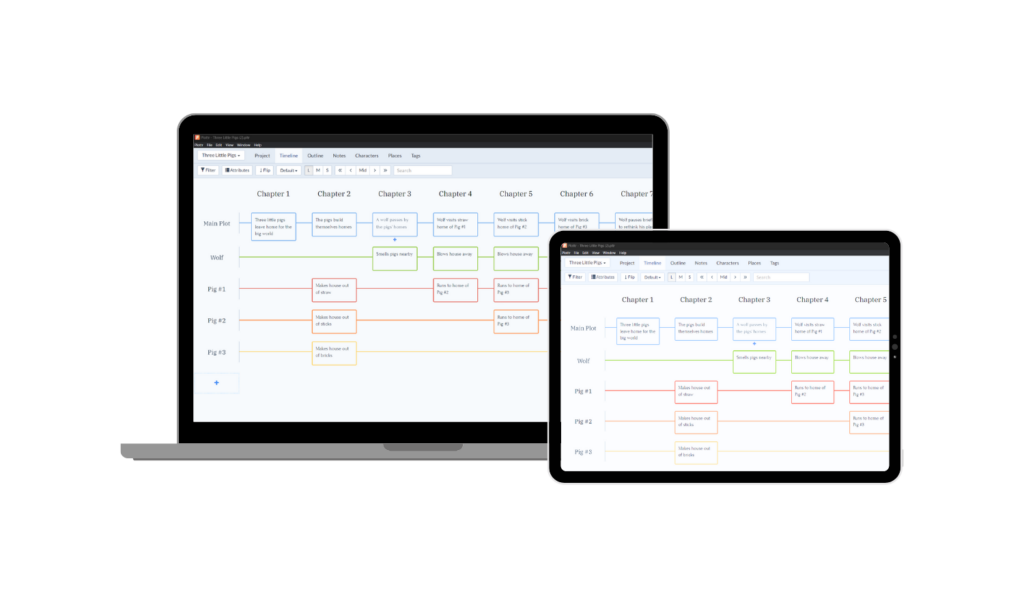Imagine waking up right as you’re dropped into a fierce battle about which you know nothing. You don’t even know how you got there. Talk about having to hit the ground running! Opening a story in the middle of the action (in medias res) is an excellent way to capture readers’ attention. The In Medias Res plot template in Plottr gives you a simple structure to do exactly this.
What is In Media Res?
In Media Res is a Latin phrase that means “in the middle of things.” Thus, in this plotting method, the story opens with the plot already underway.
The exposition that comes at the beginning in other story structures fills in gradually through flashbacks, characters’ dialogue, and time jumps.
Who is the In Media Res Plot Structure For?
The In Medias Res plot structure is best for authors who have a pretty good idea of where their stories are going. Especially the climactic scene — since this is where you’ll begin.
If you are a pantser (doing minimal outlining), this plot structure template may be more difficult to use. Pantsers often discover their stories as they write and don’t always know what the climax will look like from the first page.
Plot Points of In Media Res
In this plot template within Plottr, you’ll see the following beats — or scenes — along the story timeline.
Climax Hook
Unlike traditional story structures, this style drops the reader into the middle of the story’s climax. It offers tantalizing details to hook the reader before returning to the exposition of the story.
Due to the above, it is important to have the beginning, middle, and end of the story planned first.
The opening scene must be attention-grabbing and provoke curiosity. It should drive the reader to wonder not only how the story got to this point, but also how it will resolve.
Example: In the movie “Underworld”, the dark, rainy opening scene shows a black-clad woman, soon to be revealed as a vampire named Selene, thinking about how the war between vampires and lycans had nearly been won by the vampires when Lucian, the most feared lycan, was killed.
Now, six centuries later, the war continues and is more dangerous than ever — now, the older, more powerful lycans no longer depend on a full moon to change into werewolves. They can change at will.
The vampires’ mission remains the same: kill them off one by one. Selene reflects on how it’s been a successful campaign. “Perhaps too successful,” she says, because she is a Death Dealer and if there are no more lycans, she’ll become obsolete.
Selene is watching two lycans tail a man down the street and into the subway, and she follows. A gunfight between the vampires and lycans ensues in the subway station. The viewer is left with these questions: Why were the lycans chasing the man? What happened to him?

Exposition
After the attention-grabbing and emotional first scene, the story enters the exposition. This can be done via flashbacks, dialogue, or time-jumps. It must be done in a way that keeps tension rising without info dumps.
With the reader hooked and curious, the exposition takes the reader back before the climax. It begins to explain how the protagonist ended up in such a dire situation.
This beat does not have all the exposition. It will be scattered throughout Beats 2, 3, and 4 to maintain interest.
Example: With the fight over, Selene hears sounds in the underground tunnels that make her believe that there are more lycans than they previously believed, and now they have a new weapon in UV bullets. She also notes that the lycans were willing to fight with the vampires within full view of humans, something that hasn’t happened before.
But when she wants to verify the existence of these lycans, the current leader of the vampires, Kraven, dismisses her concern and refuses to let her. Obviously frustrated, she tells him someone named Viktor would believe her and she stalks away.
Selene looks through video footage and becomes convinced that the lycans were stalking the human man and wants to know why. Kraven dismisses her concerns again, asking why they would stalk a human for any reason other than food.
Rising Action
The story now enters the rising action, where the protagonist faces challenges on their way to the previewed climax.
Each challenge leads the protagonist closer to the dire situation from the beginning of the story.
Example: Selene finds out the man the lycans were following is named Michael Corvin. The audience sees that the leader of the lycans is working with a scientist named Singe. Singe is searching for someone in the Corvinus bloodline because there is evidently something in their blood that he wants.
Right after Selene confronts Michael at his home, lycans show up. Michael flees and gets bitten by a lycan. Selene saves him because she wants answers. Selene is injured during the escape but Michael saves her.
After she wakes up, Selene takes Michael back to the mansion where her vampire coven lives. Kraven is upset by this.
Michael starts to have visions of things that didn’t happen to him, memories belonging to the lycan who bit him.
Kraven meets with the lycan who bit Michael. He’s revealed to be a very-much-alive Lucian, and they have an arrangement of some sort. Selene saves Michael again — now from her own coven, who know he’s been bitten by a lycan. Seeking help, Selene awakens Viktor, the oldest and strongest vampire and her sire.
Selene captures Singe and brings him before Viktor. Singe reveals that the lycans want Michael’s blood because he’s descended from the first immortal, who fathered one child who became a lycan, one who became a vampire, and one who was human. They want to use Michael’s blood to combine the species’ bloodlines again to create a species stronger than both vampires and lycans. Viktor tells Selene she must kill Michael, who has been captured by Lucian.
Climax
In this beat, the story naturally approaches the climax, brings the reader back to the opening scene, and offers the resolution to that scene while leading to the story’s falling action.
The climax is the turning point for the story and the protagonist. The fallout from the climax changes the protagonist’s perspective for the remainder of the story and often leaves them at their darkest moment, where all seems lost.
Example: As the story approaches its climax, Lucian tells Michael how the centuries-long war mentioned in the opening scene actually started. The lycans were originally enslaved by the vampires, but Lucian still fell in love with a vampire. Fearing a blending of the species, Viktor forced Lucian to watch his wife, Sonya (Viktor’s daughter), burned to death by the sun.
Mirroring the first scene, a battle between the lycans and vampires ensues at the lycans’ lair, where the lycans are keeping Michael. Kraven, who was working with Lucian so that he could get rid of all three of the vampire elders in a coup, shoots Lucian with a silver nitrate bullet and believes he killed him as these bullets can’t be survived by lycans.
Kraven doesn’t know that Lucian has already injected some of Michael’s blood. He shoots Michael, then tells Selene that Viktor is the one who killed her human family and then his own daughter, which started the war.
Falling Action
The falling action explores the aftermath of the climax and its consequences for the protagonist.
If they escaped their dire situation or stole something, they may have enemies chasing after them. If they lost an important item, they might be facing the challenge of recovering it.
After the darkest moment, the protagonist is fully committed to resolving the central conflict and defeating the antagonist.
The tension increases as things seem to worsen for the protagonist, but there is a glimmer of hope.
Example: Lucian attacks Kraven, then tells Selene the only way to save Michael is to bite him. She recalls the scientist Singe revealing to her and Viktor the plan to use Michael’s blood to create a lycan/vampire hybrid that would be stronger than both species. She bites Michael but is thrown away from him by Viktor, who then attacks Michael.
Viktor is on the verge of killing Michael when Selene uses Viktor’s sword to kill Viktor instead. Selene and Michael leave the lycans’ lair. Like at the beginning of the movie, we hear Selene’s voice saying that soon the one remaining vampire elder, Marcus, will awake. Because she killed Viktor and sided with Michael, she will become the hunted.
Resolution
The story’s central conflict is resolved, the antagonist is defeated or driven off, and the protagonist is newly transformed with a changed perspective.
This beat wraps up all the loose ends and character arcs, and returns the protagonist back to their ordinary world as a changed person. If the story is part of a series, you’ll want to include some cliffhanger or hint at what comes in the next installment here.
Example: With her new knowledge of how the lycan vs. vampire war started, Selene’s entire perspective has changed. Back at the vampire mansion, Singe’s blood has crept into the sarcophagus of Marcus, the last vampire elder.
The last frame shows Marcus’s eyes opening to reveal they are black, meaning he is now also a powerful hybrid. This sets up the battle between him and Michael, which takes place in the movie’s sequel.
How Do You Use the In Media Res Plot Template?
First, make sure you have Plottr installed and that you have an active Plottr plan. Alternatively, start now for free with a 30-day Plottr trial.
- Step 1: From the Plottr dashboard, select Create from Template

- Step 2: Scroll down to the template In Medias Res, select it, then click Create New Project in the bottom right

- Step 3: You will see six beats in the Timeline view. Click on any of the scene cards to start adding your own ideas

- Step 4: Flesh out your beats and write above the line where indicated to keep the guidelines (or erase the default content and replace it)
And that’s a wrap! Now you have the in medias res plot template you need to avoid preamble and jump straight into juicy action.
This template works well with the following plot and character templates in Plottr:
Hit the Ground Running
Are you already thinking about how exciting your story could be for the reader if you dropped them in at the climax? Get started now with a free trial of Plottr and open up the In Media Res plot structure template. Let us know in the comments how it’s working for you.







Comments